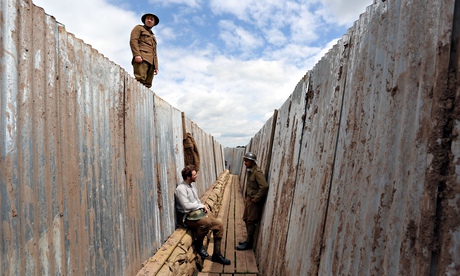
It was the sound of the gunfire that caught you, they said: something between a muffled rumble and a roar, felt in the stomach long before you got anywhere near battle. After a while, you got used to it. Only when it stopped did you start to worry.
The last place you'd expect to hear the guns of the western front would be on a sheep farm in Monmouthshire. But that's reckoning without National Theatre Wales. Having summoned to life such unlikely events as a re-enactment of Christ's Passion in industrial Port Talbot and ancient Greek tragedy in the Brecon Beacons, this summer NTW is attempting an even more audacious challenge: making site-specific theatre from the first world war.
The project commemorates an episode notorious in Wales: the Battle of Mametz Wood of July 1916. An opening move in the Somme offensive, Mametz was intended to be both surgical and painless. The 38th Welsh Division would dash forward and seize a forest 20 miles north-east of Amiens, cracking open the German lines. But it didn't work like that. After five gruelling days of fighting, some of it with bayonets, 4,000 Allied troops lay dead or injured, and perhaps as many Germans. The forest itself was roughly a square mile. It was recaptured within weeks.
The driving force behind NTW's commemoration-recreation is the poet Owen Sheers, who came across the story in 2001 when filming in France with the documentary-maker Christopher Morris, and later wrote a 21-line poem about the experience. "There was something about Mametz that fascinated me," he explains. "But it wasn't until Chris came back and suggested there was enough material here for a play that I thought about developing it." He laughs. "I said yes, but only if we can dig a trench, put the audience and cast inside it, and send them over the top."
The obvious organisation to do this was NTW, which in the five years of its existence has created work in sites ranging from a fleet of taxis prowling Cardiff (2010's The Soul Exchange) to a sizeable portion of Anglesey (2013's Things I Forgot I Remembered). Less than six months after a farmyard location near the historic village of Usk was finally confirmed, the show is about to open.
Audiences will approach up a steep hill, before being invited on what seems like a guided battlefield tour. But as they continue to walk, reality will gently slip away. A tunnel transforms into a trench, complete with lazing infantrymen; a cowbarn transmogrifies into an estaminet somewhere behind the lines. Just out of sight lurks no man's land. Beyond are the shadows of the wood.
The aim isn't theme-park re-enactment, says NTW's artistic director John McGrath; instead the piece dwells on memory and loss, braiding together past and present, with the words of soldiers spoken alongside new text composed by Sheers. As we pace the route together, he points out subtle interventions in the landscape – a torn palisade of wooden pallets here, coils of telephone cable there, not to mention the omnipresent rumble of gunfire (delivered by loudspeaker and alarmingly plausible). Even on a bright June morning, I have a sense of intruding on ghosts. "There isn't a past to this world," says McGrath. "It's in the present."
"It's not like an exhibition in a museum," adds director Matthew Dunster. "We're not aiming to be literal. It'll hopefully be much more suggestive." Lest anyone be unduly anxious about the word "immersive", both are keen to point out that gas masks will not be required.
One of the remarkable aspects of the Mametz story is how – even by the poetically overwrought standards of the first world war – it provoked such an outpouring of writing. It was at Mametz that Siegfried Sassoon, serving with the Royal Welch Fusiliers, mounted a near-suicidal one-man assault, while Robert Graves (another Fusilier) wrote of how, afterwards, "not a single tree in the wood remains unbroken".
The show draws extensively on the accounts of two Welsh writers: Llewelyn Wyn Griffith, whose Up to Mametz is a classic officer's memoir; and the artist David Jones, a Londoner of Welsh extraction whose prose poem In Parenthesis is a shattering attempt to capture battle in the fractured language of modernism (it describes a shell-burst as "a consummation of all burstings out; all sudden up-renderings and rivings-through … all barrier-breaking – all-unmaking").
Even if Rupert Brooke's "corner of a foreign field that is forever England" now rings hollow, we are still too prone to think of the first world war as a uniquely English tragedy, argues Sheers: "At Mametz there were soldiers from all across Wales fighting alongside second- and third-generation Welsh from London, Scots, Canadians, many more … It was a world war."
Sheers and Dunster hope the outdoor setting will lend another resonance, too. Despite the industrial scale of the slaughter, much of the western front fell across agricultural land; it is one of the war's many mournful ironies that boys from rural Wales found themselves dispatched to similar landscapes in continental Europe. Even now, French and Belgian farmers talk of the "iron harvest" thrown up by ploughing, along with battlefield corpses. "You can't sit in a room and make a piece like this," says Dunster. "You have to get out there."
Meanwhile, as McGrath and I reach the wood, the sound of gunfire pauses. For a moment there is silence across the valley. Then the birds take over.
• Mametz, co-commissioned by National Theatre Wales and 14-18 NOW, is at Great Llancayo Upper Wood, near Usk in Monmouthshire, from 24 June to 5 July

